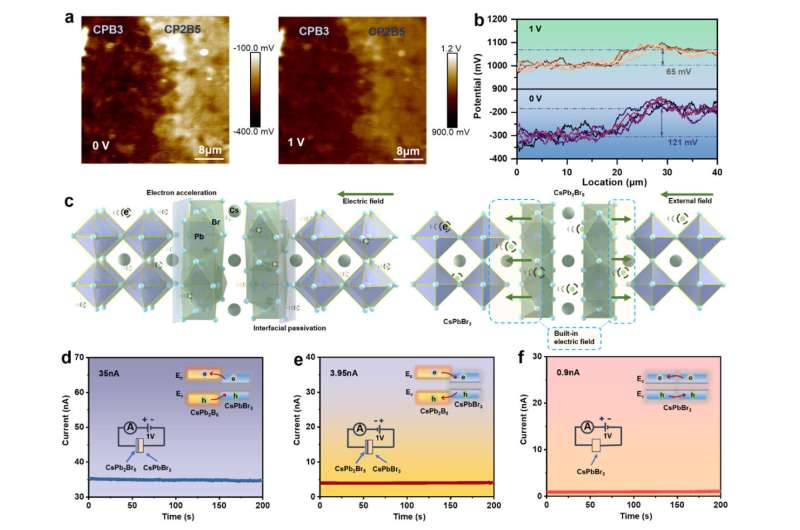The introduction of CsPb2Br5 enhances the transport of charge carriers within CsPbBr3. Credit: WANG Changmao
A recent study conducted by the research team at Hefei Institutes of Physical Science of the Chinese Academy of Sciences, has introduced a new method for enhancing X-ray detection by incorporating out-of-phase CsPb2Br5 perovskite into CsPbBr3 bulk material.
"We achieved really good sensitivity for detecting X-rays (2.58×105 μC Gyair-1 cm-2), and a low detection limit (127.9 nGyair-1)," said Prof. Pan Xu, who led the team, "We also integrated this technique with a thin-film transistor (TFT) plate to make X-ray images."
The relevant results were published in Advanced Functional Materials.
Metal halide perovskite is a promising material for detecting things like X-rays, offering better sensitivity and resolution than traditional detectors. Inorganic perovskite CsPbBr3 has excellent environmental stability and unique high-temperature plasticity, rendering it particularly advantageous for X-ray detector and imaging applications.
However, making single-crystal CsPbBr3 is difficult and expensive, and polycrystalline CsPbBr3 devices have low electron mobility, limiting their use in certain imaging systems.
In this study, scientists developed a new method called the Out-of-Phase Articulation Strategy (OPAS). They used OPAS to combine a special material called CsPb2Br5 with another material called CsPbBr3. They made a mixture of these materials using a technique called high-energy mechanical ball milling. Adding CsPb2Br5 didn't decrease the current baseline.
Instead, it helped to speed up the movement of electrons and holes, which are important for detecting X-rays. This improvement was possible because CsPb2Br5 created pathways for the electrons and holes to move more easily within CsPbBr3. Using this method, they achieved high sensitivity and spatial resolution for detecting X-rays without needing a lot of voltage.
In addition, the researchers put together CsPb2Br5/CsPbBr3 on TFT backplanes to realize multi-pixel X-ray surface-array imaging. This proved that CsPbBr3 material can be used for imaging.
"It also gives us a new material system and design concept for using chalcocite in X-ray imaging," added Ye.
This work shows that perovskites with the introduction of a 2D phase exhibit carrier transport effect and good long-term stability which making them promising candidates for commercial use.
More information: Changmao Wan et al, Out‐Of‐Phase Articulation Strategy of CsPbBr3/CsPb2Br5 Perovskite for High Sensitivity X‐Ray Detection, Advanced Functional Materials (2024). DOI: 10.1002/adfm.202401220
Journal information: Advanced Functional Materials
Provided by Hefei Institutes of Physical Science, Chinese Academy of Sciences
























